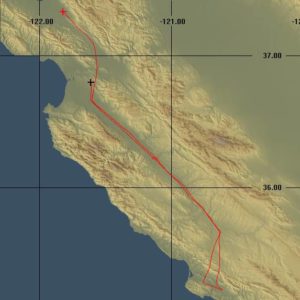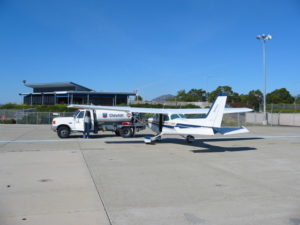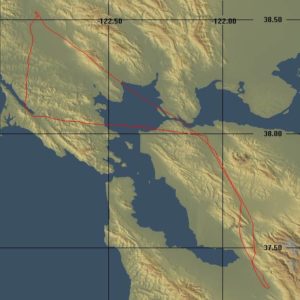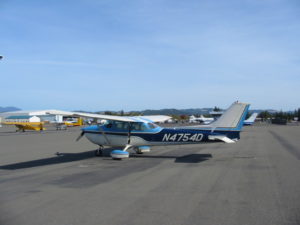Category: Learning to Fly
Monday November 11th 2002, 10am, N4754D, 2.6H
Sunday November 3rd 2002, 12pm, N5766J, 2.2H
 A big day, my first solo cross-country flight. Reading back to some of the early entries in this journal, I’m amazed how much I’ve learned, how far I’ve come. Many of the later entries have almost become routine, I flew here, I did that and so on. They fail to capture the wonder and excitement of flying. Now, a little over two months since I started, I’m to be set loose with a plane all on my own to take it somewhere I never been before, fly through unfamiliar airspace hopefully proving that I’ve learned something in those last two months. It should feel like a big deal, but truthfully I feel more than ready for it, no nervousness, no jitters, just keen anticipation to be in the air. I talked with Grainne last night, she told me the destination for my first big excursion is to be Davis, “Yolo County/Winters/ Woodland/Davis Airport” to be exact (stupid name for an airport, you can just imagine the various bodies arguing over the name and eventually deciding to call it that just to keep everyone happy), its code is 2Q3 and I’ll call it that to save on hard disk space. I got all the preflight planning done last night and I arrived early to get the DUATS briefing and make the final calculation for the forecast winds. Grainne checked through everything and then endorsed my log book and license for solo cross-country with another endorsement for this specific flight. The route I will follow is up I-680, past the east side of Mt Diablo, over the top of Travis Air Force Base, over the top of Nut Tree Airport and then down into 2Q3 for a trip of 74 nautical miles. I’ll come back via the Scaggs Island VOR and Buchanan Airport following pretty much the same route as the night cross-country home which is 92 nautical miles.
A big day, my first solo cross-country flight. Reading back to some of the early entries in this journal, I’m amazed how much I’ve learned, how far I’ve come. Many of the later entries have almost become routine, I flew here, I did that and so on. They fail to capture the wonder and excitement of flying. Now, a little over two months since I started, I’m to be set loose with a plane all on my own to take it somewhere I never been before, fly through unfamiliar airspace hopefully proving that I’ve learned something in those last two months. It should feel like a big deal, but truthfully I feel more than ready for it, no nervousness, no jitters, just keen anticipation to be in the air. I talked with Grainne last night, she told me the destination for my first big excursion is to be Davis, “Yolo County/Winters/ Woodland/Davis Airport” to be exact (stupid name for an airport, you can just imagine the various bodies arguing over the name and eventually deciding to call it that just to keep everyone happy), its code is 2Q3 and I’ll call it that to save on hard disk space. I got all the preflight planning done last night and I arrived early to get the DUATS briefing and make the final calculation for the forecast winds. Grainne checked through everything and then endorsed my log book and license for solo cross-country with another endorsement for this specific flight. The route I will follow is up I-680, past the east side of Mt Diablo, over the top of Travis Air Force Base, over the top of Nut Tree Airport and then down into 2Q3 for a trip of 74 nautical miles. I’ll come back via the Scaggs Island VOR and Buchanan Airport following pretty much the same route as the night cross-country home which is 92 nautical miles.
Had a nice normal preflight etc. and tookoff on a right 45 departure to head over the top of Mission Peak, climbing to 4500’. I called Oakland Flight Service Station and opened the flight plan I had filled on the ground. Then called Bay Approach and got flight following. Got passed off to another controller shortly afterwards. I flew almost due north over Livermore and reached Mt Diablo just 2 minutes later than I’d calculated. I got passed off to Travis Approach and stayed with them as I flew right over the top of the base. There are two huge runways (similar to the one I landed on in Castle) and I could see dozens of C130 Transports lined up on the Apron. I got passed off to another Travis controller as I turned over the base to head for Nut Tree. This is a small airport right next to I-80 and a big restaurant – I’ve heard the restaurant is closed now, but the airport is still open. Nut Tree was my planned start of descent and I turned onto what I thought was the right heading and started down. I couldn’t see 2Q3 and my trusty GPS attached to the yoke with rubber bands was telling me it was well left of the direction I was flying. I finally decided to believe the GPS and turned more to the left and hey presto there was 2Q3 (I worked out later I turned onto the true heading, not the magnetic heading, which meant I was off by 15 degrees). I called Travis Approach and terminated flight following, he warned me that there was parachute jumping taking place on the east side of the airport. This was fine, I planned to come in from the west. Got tuned into the CTAF frequency for 2Q3, there was one plane in the pattern doing touch and go’s and another plane with the parachute jumpers. I got down to pattern altitude well west of the field and made a wide right turn to come in on the left 45 for runway 34. Its a big wide runway and I got down without any trouble. I taxied off the runway and just parked in an empty spot (there was a lot of empty spots), shut off the plane, got out, closed my flight plan over the phone and smoked a cigarette. It was a long was to come just to have a smoke, but there was f**k all else there. The time I recorded when I got to the parking spot was 13:53 which was 59minutes after I took off from RHV and 10minutes longer than I’d originally calculated it would take, the headwind was just a bit stronger than forecast.
Got setup for takeoff again with a quick run-up just short of the runway. Did a left crosswind departure and contacted Rancho Radio to open the return flight plan, then got setup for flight following again with Travis Approach. I made a bit of a mess getting onto the radial I wanted for Scaggs island, but eventually worked out that my Heading Indicator had wandered off and it worked just fine when I reset it to the compass. I climbed up to 4500’ and flew over the top of Napa County Airport. Just passed there I turned south to intercept the outbound radial from the VOR and descended to 3500’. The view of San Francisco, the Bay Bridge and the Golden Gate Bridge was spectacular. About this time I got passed off to Oakland Approach who shortly passed me back to Travis Approach as I passed over the Carcinas Bridge. I turned south again over Buchanan Airport in Concord and started following I-680 south. I got passed off to Bay Approach on the way down who finally gave me the RHV ATIS and terminated flight following just over Sunol. RHV Tower had me enter the right downwind for 31R and I had a nice uneventful landing. Time on the ground was 15:10, just 56 minutes after taking off from 2Q3 and just 3 minutes longer than my original calculation.
So that was my first solo cross-country. 166 nautical miles and almost 2 hours flying time. It was blissfully uneventful, no problems, no major mistakes and nice and safe the whole way. A good start to what I hope turns into a long cross-country flying career.
Saturday November 2nd 2002, 11am, N739YE, 2.0H
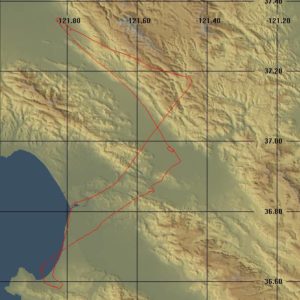 Today was my stage II checkride. Like the stage I check this is 2 hours oral test and then 2 hours flight test. The focus this time is on cross-country work, weather and decision making. Its not really a test, but its organized the same way as the FAA checkride so that your first time flying with a stranger isn’t when its the FAA examiner. We had a hard time finding a senior CFI to do the checkride, but Grainne set it up with a part time instructor called Todd Shara. Todd is an Air Transport Pilot flying for Sky West which does short haul commuter flights in California. Grainne had told me to prepare a flight plan to Fresno and to have all the weight and balance calculations done. I like to have the AOPA airport directory pages in my kneeboard and I’d managed to forget to print out the ones I needed on Friday, so I headed into work early printed the diagrams I needed for Fresno and some other airports along the way. I also got the DUATS briefing and completed the flight calculations. I managed to get all this done and get to RHV for 9am – It was an early start and I arrived just a couple of minutes late. Todd was waiting for me, he is a big fresh faced guy, quiet spoken.
Today was my stage II checkride. Like the stage I check this is 2 hours oral test and then 2 hours flight test. The focus this time is on cross-country work, weather and decision making. Its not really a test, but its organized the same way as the FAA checkride so that your first time flying with a stranger isn’t when its the FAA examiner. We had a hard time finding a senior CFI to do the checkride, but Grainne set it up with a part time instructor called Todd Shara. Todd is an Air Transport Pilot flying for Sky West which does short haul commuter flights in California. Grainne had told me to prepare a flight plan to Fresno and to have all the weight and balance calculations done. I like to have the AOPA airport directory pages in my kneeboard and I’d managed to forget to print out the ones I needed on Friday, so I headed into work early printed the diagrams I needed for Fresno and some other airports along the way. I also got the DUATS briefing and completed the flight calculations. I managed to get all this done and get to RHV for 9am – It was an early start and I arrived just a couple of minutes late. Todd was waiting for me, he is a big fresh faced guy, quiet spoken.
The oral test went well. We started with the route I’d picked out which was basically a straight line from RHV to FAT. Todd had a problem with simply flying over the mountains to the east of San Jose, firstly would the plane climb fast enough to clear the 3500’ peaks and the fact that there is no place to land if the engine quits. He would have chosen to fly south to Frazier Lake and then follow highway 152 into the central valley. He asked me various questions about the airspace along the route, how I’d get information on weather, how I’d find the frequency for Air Traffic Control. He had a bunch of what if questions, like “What if you’re at Los Banos and Oakland Radio tells you that the Bay Area is fogged in from Oakland to Hollister, good night”, answer go land somewhere like Merced and stay the night. We went through the Sectional making sure I could read the airport information, VOR info etc. The test was supposed to take two hours, we finished in a little over one. The plane wasn’t back so we just chatted while we waited for it to arrive.
The pre-flight and taxi went well, I didn’t forget anything. I had some problems with the run-up, the left magneto was really rough. Like I’d been shown I ran the engine up to 2200 RPM for 10 seconds to burn off any carbon deposits, when that didn’t work I tried full power for 20 seconds. That still didn’t work so Todd showed me a trick, you lean the engine (adjusting the mixture to get max RPM) and then let it run there for about 30 seconds. This makes it run hot – its not recommended but better than grounding the plane for a bad magneto when in fact the plugs are just a little fouled. This did the trick and we were ready for takeoff. I did a fine short field takeoff and downwind departure.
The first checkpoint was the Top of Climb, we hit it 2 minutes late, but within the spec. (inside 5 minutes) and leveled off at 5500’. I established the plane in cruise and finished the checklist and then got the Salinas VOR tuned in and identified as I planned to use a radial to confirm my next checkpoint. At this point Todd tells me to divert to Salinas – I’m thinking this is too easy, I’ve just setup the VOR so the DME (Distance Measuring Equipment) will tell me the distance and time to the VOR for free. Todd realizes this just about the same time I do and says, “Wait, Salinas just shut down, divert to Monterey”. We had talked about my one trip into class C (on the night flight to San Jose International) and Todd decided this would be a great opportunity to get some more class C experience with Monterey. The weather was perfect, I could see all the way to the coast out to the Monterey Peninsula so pointing the plane in the right direction was pretty easy. Still, I remembered to note the time, got a new heading worked out (195), measured the distance on the chart (45 nm), used the E6B to calculate an ETE (24 minutes) & ETA (12:22) and worked out the fuel in my head (3.5 gallons). However, I forgot to change my altitude for the new heading, Todd reminded me and I descended to 4500’. Then he had me try and look up the AFD to find out whatever I could about Monterey (I hadn’t anticipated Monterey ahead of time so I didn’t have the AOPA directory sheet in my knee board folder). I managed to get the various frequencies, runway lengths and pattern altitude, but it was messy trying to read the book and fly the plane at the same time. We discussed how to get into Monterey class C, I knew about calling up Monterey Approach, but I wasn’t sure about how I’d give them a position fix. Todd suggested we head to Moss Landing (a huge power station, right on the coast, just outside class C) and call them from there. By this time I’d lost a bit of altitude and I was playing with getting back to 4500’ when he told me I really had more important things to think about, like getting the ATIS and getting in contact with Air Traffic Control. I made a dumb mistake getting the ATIS, I’m so used to just tuning out the Reid Hillview ATIS once I’ve got the winds and altimeter setting that I did the same here. So of course I didn’t find out what runway was in use. Todd asked me what runway I was going to use and I sheepishly turned the ATIS back on to find out. I got a hold of ATC just over the power station, they replied with my call sign and told me to standby for a transponder code. Todd, asked me, “Did I think I could enter class C?”, I said, “I believe so” and he said “so do I”, – we had established two way communication with ATC. A good trick he told me was to make sure my altitude was above 4200’, the top of class C airspace, that way I couldn’t blunder in by mistake without clearance. We were finally given a transponder code and told to ident, then told to ident again, finally the controller asked, “Are you the plane directly over the mouth of the Salinas River?”. I looked down and sure enough there was a river, so I told him I was. At this point he told me to contact the tower. We were still almost 10 miles out, but they gave a clearance to land on 28R (the shorter runway). No other instructions, no preferred pattern entry, nothing. Usually a tower gives you more explicit instructions like “Make left traffic for 28R, report 2 miles on the 45”. So I assumed a standard left traffic pattern and aimed for the 45 entry to left traffic for 28R. Other than committing my usual sin at unfamiliar airports of getting too close to the runway on downwind the pattern entry and landing were fine. Todd told me to do a short field landing. I couldn’t understand why the plane floated so much down the runway. It turned out I left just a little bit of power in and so I turned it into a perfect soft field landing.
We called Ground Control and asked to taxi for takeoff. I was told to standby for a departure instructions and then they came back with, “Depart straight out, after the freeway turn to heading 340, Monterey Approach frequency 127.15”, I read this back and they confirmed I’d got it right. I called the Tower again at the hold short line and got a takeoff clearance, an Eagle Air commuter jet took off beside us just as I lined up on the runway. Todd told me to make a soft field takeoff, I did a passable job, but really didn’t get into ground effect until I was already going fast enough to takeoff normally. I climbed out over the freeway, turned to heading 340 which takes you out over the bay. At about 1800’ I was told to contact Monterey Approach. They told me to resume my own navigation above 2000’, so I turned back towards dry land as soon as I got the chance. Todd, told me to let him know when we were clear of class C, this was fairly easy, there is a kind of lagoon on the coast that marks the boundary. Once out he had me put on the hood for some instrument work.
He had me level out at 3500’, fly some headings and determine the radial I was on from the Salinas VOR. Then we did some recovery from unusual attitudes. I think we did three, two nose down and one nose up almost in a stall. I messed up the first one a bit, not leveling the winds before pulling out of the dive. I was a bit confused about cross checking the turn coordinator with the attitude indicator. Previously I’d been told check the attitude indicator first – then quickly cross check the turn coordinator to make sure. Todd told me to do the opposite, because of the possibility that the attitude indicator has tumbled. So spent too long looking at the turn coordinator, trying to level the wings, I thought they were coming level and I started to pull up the nose, then I looked at the attitude indicator and saw my wings were still banked left – so then I leveled them using the attitude indicator. The plane ended up straight and level, but Todd wasn’t happy about not leveling the wings first. I got the hood off and he told me to head for home.
A little passed Frazier Lake Todd asked me was there a checklist in the side pocket, this was just a ploy to get me to take my hand off the throttle which he promptly pulled out. I established best glide speed and thought I could make it to South County, he kept saying are you really sure, I said I thought I could but that it was close to the limit of the glide. Then he said assuming I couldn’t then where would I land, so I turned the plane around and started heading for Frazier Lake, which in hind sight was the right answer in the first place. So I fell for the Frazier Lake ploy again – forgetting this little airfield is there. he told me to turn back for home, took over flying the plane and gave me a lecture on how there was no way he would have tried to make it to South County when there was a good airfield so close and how even if there wasn’t he would have put it down in a field rather than try and fly into a built up area without being sure of getting to a landing spot. So lesson well learned – go for the sure thing when the engine fails.
Had a nice uneventful flight back to RHV. Todd had me do a short field landing which went perfectly this time. Other than the recovery from unusual attitudes and the emergency landing he said I did fine on the stage check evaluation – ready for my solo cross country. The flight was fairly long, but it went well overall. I really feel ready for flying cross country on my own.
Thursday October 31st 2002, 3pm, N5766J, 1.5H
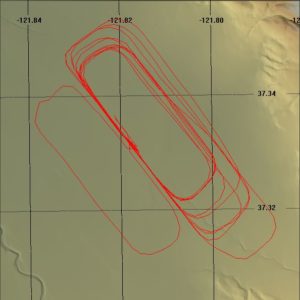 The weather this week had just been so perfect, it feels like the last gasp of summer. The wind was 290 at 10 knots and the temp was 21C with 20 miles of visibility, there were just a few scattered cirrus at 20,000’. After last nights flight all my problems of last Monday were forgotten, 5766J is just a friendly plane to fly and she’s never been bad to me unlike that treacherous 8276E. No problems whatsoever with the pre-flight, taxi or run-up. Took off on 31R and entered right traffic and once again was flying solo. I have to remind myself that its only three short weeks since I soloed for the very first time. It’s like night and day – no fear only the enjoyment of getting into the air.
The weather this week had just been so perfect, it feels like the last gasp of summer. The wind was 290 at 10 knots and the temp was 21C with 20 miles of visibility, there were just a few scattered cirrus at 20,000’. After last nights flight all my problems of last Monday were forgotten, 5766J is just a friendly plane to fly and she’s never been bad to me unlike that treacherous 8276E. No problems whatsoever with the pre-flight, taxi or run-up. Took off on 31R and entered right traffic and once again was flying solo. I have to remind myself that its only three short weeks since I soloed for the very first time. It’s like night and day – no fear only the enjoyment of getting into the air.
I stayed in the air for 1.5 hours. Previously I’d have been exhausted doing pattern work for this long. Now I’m easily ahead of the plane, the focus is just on refining technique, its not tiring, its just fun. I feel like I’ve been climbing a mountain and suddenly the hill got a lot less steep. After the problems getting too my first solo and then finally getting it over with, the progression has just been so fast. Back then I thought it was a stretch goal of getting my license by Christmas. Now its looks easily attainable if I’m lucky with weather in November. Granted, I’ve been flying a lot this month almost 19 hours since my solo, so I’m probably just on track with the average, its just I’ve compressed it into 3 weeks.
I did 10 landings and one go-around. I focused on short field landings because they’re most of the soft field technique anyway. The first three floated a bit and I touched down farther along than I wanted. Then I tried just slowing up just a little bit on final, a touch under 60 KIAS and bang, right on the numbers they started working. On most of the landings I was able to get off on taxi way Bravo which is the very first available taxiway, I never went beyond taxiway Charlie. Not a single landing was out of control. It was just landing nirvana today. I mixed in some short field takeoffs and these went well. The go-around was caused by another pilot, one of the Japanese students from Nice Air. The tower thought he asked for a downwind departure, he obliviously thought he was doing closed pattern work. Either way he ended up on final when the tower asked him what the hell he was doing because he had no clearance to land. He then got into a debate with the tower whether he asked for closed pattern work or a downwind departure. All this time there was another plane holding for takeoff on 31R. By the time the tower had stopped talking the Japanese guy was on short final and the plane holding on 31R had never got a clearance to takeoff. So the Japanese guy got told to go-around because of the plane sitting on the runway. I had just turned onto final following the Japanese guy so I got told to go-around as well.
All in all today was a great flight even if it was just circles around the airport. I never made a mistake, the radio work was good and the landings were great.
Wednesday October 30th 2002, 6:30pm, N5766J, 1.8H
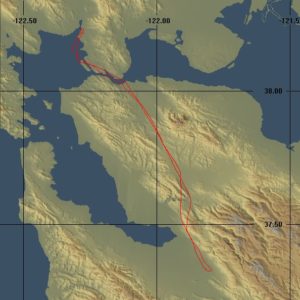 Tonight the weather was picture perfect for flying. The air was clear and cool and visibility was better than 10 miles. There was the usual evening breeze from the Northwest blowing almost straight down the runway. The flight planning for this trip to Napa County Airport was a bit rushed. I had planned to get it done the night before, but I ended up having dinner and a couple of beers with some friends so I wasn’t in the mood when I got home. Instead, I spent lunch time at work getting most of the planning done and then finished up the last bits when I got to Tradewinds about 5:30pm. Grainne was waiting when I got there and we went over the plan. She had told me to avoid SFO’s class B airspace, so I planned a route following I680 up to Concord and then track in towards Napa on the Scaggs Island VOR. I was going to use the DME (Distance Measurement Equipment) to determine my turn point towards NAPA. The distance was 59nm and it should take about 39minutes to fly. After Grainne was done checking the flight plan I filed it and we headed out to find 5766J.
Tonight the weather was picture perfect for flying. The air was clear and cool and visibility was better than 10 miles. There was the usual evening breeze from the Northwest blowing almost straight down the runway. The flight planning for this trip to Napa County Airport was a bit rushed. I had planned to get it done the night before, but I ended up having dinner and a couple of beers with some friends so I wasn’t in the mood when I got home. Instead, I spent lunch time at work getting most of the planning done and then finished up the last bits when I got to Tradewinds about 5:30pm. Grainne was waiting when I got there and we went over the plan. She had told me to avoid SFO’s class B airspace, so I planned a route following I680 up to Concord and then track in towards Napa on the Scaggs Island VOR. I was going to use the DME (Distance Measurement Equipment) to determine my turn point towards NAPA. The distance was 59nm and it should take about 39minutes to fly. After Grainne was done checking the flight plan I filed it and we headed out to find 5766J.
5766J had just been washed and was sitting out behind the Tradewinds hanger. It turned out it hadn’t been flown since I found the alternator problem the previous Sunday. We had checked the maintenance log, the alternator regulator had been replaced and this had fixed the problem. I completed a dark and cold pre-flight and the long taxi out to the runway. Tonight we were making a straight out departure from 31R just following to the East of the freeway to stay clear of SJC’s class C. The takeoff and departure was fine. I got Oakland Radio on the climb out and opened my flight plan and then managed to setup flight following like I knew what I was doing. We leveled off at 4500’ over Sunol more or less right on time. The view was spectacular, the whole Bay Area was a sea of lights spread out under us.
The flight North along I680 was smooth and uneventful, we were passed to Sierra Approach just before Livermore. There was a lot of traffic on the radio, I guess it was the evening rush hour of planes into and out of the Bay Area. I turned onto the Scaggs Island VOR radial over Buchanan Airport in Concord and started out over the Benicia Bridge into San Pablo Bay. I tuned into the Napa ATIS and got the weather. There was a 7 knot wind at 150 degrees and runway 18R was in use. This was no surprise its the main runway with lights. Its real dark out over the water, when I planned the trip I thought it might be difficult to find the airport, I had planned using the DME to time my turn towards the field. In the event it was really easy to pick out the airport and I didn’t need the DME. I called the tower and was told to enter right downwind for 31R, it sounded like there was no other traffic flying at the time.
I turned right and started the descent and made the same mistake I’d made at Pine Mountain Lake, I got way too close to the runway on the downwind. This time at least I recognized what I was doing wrong and tracked away from the runway on the downwind to give myself more space on the base leg. The approach was fine and I thought the landing was fine, though Grainne got a bit excited. I was starting the flare and she kept saying “just hold it level”, I could see her almost grabbing the yoke. 18R is another big runway like Castle (5900’) with wide runway markings. I guess I flared a bit high because the “normal” sight picture I’m used to in RHV or Q99 fooled me into thinking I was lower (that is a big runway far away looks the same as a small runway close up). Either way we touched down pretty gently. The tower told us to taxi to the ramp on his frequency and we had fun finding a taxiway diagram to work out how to get back to the start of the runway. Napa is one of those triangular airports with three runways making up the sides, this makes the taxiway layout a bit complicated. Luckily we didn’t get lost, got a clearance to taxi for takeoff, found our way back to the start of 18R and were cleared to take off. I closed the flight plan on the way up.
The flight back was relaxing, just using pure pilotage, no dead reckoning. Grainne had planned some hood work, but by the time I got flight following setup we were over Concord at 3500’ and pretty much hemmed in by the mountains on both sides so no more hard work tonight. I flew us down 680, over Sunol, Sierra Approach gave us the RHV ATIS and terminated flight following. I called RHV tower along side Mission Peak and was told to enter right downwind for 31R. We were just on the downwind when Grainne pulled the power on the engine for yet another dead stick landing. It’s amazing how the engine always quits over Lake Cunningham. Got best glide and turned onto base and final. I had 10 degrees of flaps in and hummed and hawed about putting more in, finally putting in 30 degrees over the Mall. The landing was so gentle, the plane’s wheels just kissed the ground hello, really good! I let her roll to the last taxi way and we headed for parking. Tonight was pure joy, perfect weather, the air was smooth as glass and everything went exactly to plan. I’ve got another solo flight tomorrow. Grainne wants me to do the Stage II checkride on Saturday so I’ll just stay in the RHV pattern and practice the short & soft field takeoffs and landings.
Monday October 28th 2002, 2pm, N8276E, 1.1H
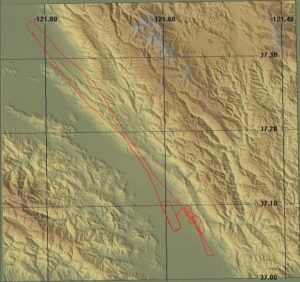 Another perfect solo weather day. I ended up with 8276E today, a plane I’d only flown once back in August and the oldest most worn Skyhawk in the Tradewinds fleet. The pre-flight went well, although I couldn’t make much sense of the audio panel, I used my full headset to call up for fuel because I couldn’t work out how to make the cabin mic work. This plane is hokey, the avionics are old and everything about it is worn around the edges. I had a normal downwind departure and headed back to the same area as I’d practiced in yesterday. My plan was to practice slow flight and stalls and then do some landings again at South County.
Another perfect solo weather day. I ended up with 8276E today, a plane I’d only flown once back in August and the oldest most worn Skyhawk in the Tradewinds fleet. The pre-flight went well, although I couldn’t make much sense of the audio panel, I used my full headset to call up for fuel because I couldn’t work out how to make the cabin mic work. This plane is hokey, the avionics are old and everything about it is worn around the edges. I had a normal downwind departure and headed back to the same area as I’d practiced in yesterday. My plan was to practice slow flight and stalls and then do some landings again at South County.
As I flew passed Anderson Reservoir I started to get what I can only describe as “the jitters”. Even though I’ve done stalls and slow flight in every other plane in the fleet, 8276E was sufficiently different to make me nervous. I decided to skip the stalls and just do some slow flight and even then I started getting scared about stalling by mistake. It was as if all the confidence I had built up over the previous solo flights had evaporated. Truly I got myself more scared and nervous then my very first solo flight. I slowed down to 55 KIAS and just flew it straight at that speed just practicing maintaining my altitude – this was pretty basic stuff, but I just wasn’t ready to try anything more difficult. As I powered up again event the engine sounded wrong to me – even though it was just fine. It was like my mind was just looking for things to stress me out. As I was at 4000’ I decided to do a forward slip to get down. This is a fairly basic maneuver and it went well, I kept my heading and airspeed pretty constant and lost about 1500’ before coming out of the slip and turning back towards South County.
There was no one else in the pattern at South County as I entered the right 45 for runway 32. I had a pretty normal approach, just aiming for a standard landing with nothing fancy. It went badly wrong in the flare. The plane ballooned up and then started slipping sideways to the right. I added some power but the bottom dropped out and I clunked down onto the runway at a slight angle. My front wheel came down quickly and started to shimmy. It was a mess, I got the weight of the nose wheel and it stopped complaining. This was by far my worst landing in a very long time and it did nothing to help my already diminished confidence. Based on the theory that you climb right back on the horse that you just fell off, I decided to do another circuit of the pattern. I had just powered up for the takeoff when I realized my window was open, so I quickly brought the power back and closed the window – so much for following the checklists. This time through the pattern the approach was good but the landing was only marginally better. I still ballooned up and drifted sideways a bit, but I didn’t come down as hard or as uncontrolled. Still, it didn’t help boast my confidence much. I decided I’d had enough and tookoff for home.
On the straight in approach to 31L the jitters started again in earnest. I had to keep telling myself, I’ve done this plenty of times, its just the same, just follow the standard sequence. The approach went fine to spite being nervous and the landing was ok, if a bit flat. After the ballooning down in South County I under-compensated and didn’t really flare enough. Still, I was happy to be back on the ground in RHV. Today’s flight was really no fun. I didn’t realize just how much an unfamiliar plane would effect me and was surprised at how debilitating the fear could be. It was an unpleasant lesson but one well learned.
Sunday October 27th 2002, 12:30pm, N739YE, 1.4H
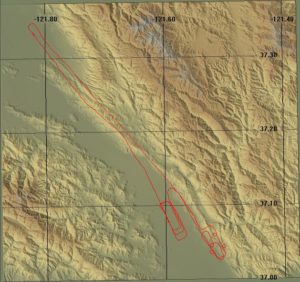 I’ve fallen a bit behind in my journal so I’ll keep these entries short. Finally the weather started behaving and I could fly solo again. The last solo I’d done was almost two weeks ago when I was checked out to land in South County and Hollister. I was keen to finally get out into the practice area on my own, all my other solo‘s were in the pattern at RHV. It was a beautiful day, not too warm, no wind and 10 miles visibility. I was supposed to be flying N5766J, when I asked for the book they told me that the last pilot had squawked it for the low voltage light coming on. I know that some of the planes will flash this light if the engine is at low RPM and you have the landing light and transponder on so I decided I’d take it and just keep a close eye on the ammeter. I got thought the external pre-flight and started on the internal checklist when I discovered that the ALT FIELD circuit breaker was popped. I reset it, switched on master and it popped again – there was some problem with the alternator so 5766J was grounded. I was lucky that someone had just cancelled 739YE so I got it. Another pre-flight and this plane was ready to go.
I’ve fallen a bit behind in my journal so I’ll keep these entries short. Finally the weather started behaving and I could fly solo again. The last solo I’d done was almost two weeks ago when I was checked out to land in South County and Hollister. I was keen to finally get out into the practice area on my own, all my other solo‘s were in the pattern at RHV. It was a beautiful day, not too warm, no wind and 10 miles visibility. I was supposed to be flying N5766J, when I asked for the book they told me that the last pilot had squawked it for the low voltage light coming on. I know that some of the planes will flash this light if the engine is at low RPM and you have the landing light and transponder on so I decided I’d take it and just keep a close eye on the ammeter. I got thought the external pre-flight and started on the internal checklist when I discovered that the ALT FIELD circuit breaker was popped. I reset it, switched on master and it popped again – there was some problem with the alternator so 5766J was grounded. I was lucky that someone had just cancelled 739YE so I got it. Another pre-flight and this plane was ready to go.
Everything went well until I got to the hold short line of 31R. I called the tower and got no response, I tried ground control and same result, Oh no, he we go again with the radio problems. I turned back around and parked myself in the run-up area again to see if I could work it out. It only took a minute, the speaker jack had pulled out of its socket so I couldn’t hear anything. I got it plugged back in, got back to the hold short line and was cleared to takeoff.
I didn’t have a real firm plan what I was going to practice, other than some landings at South County. I really just wanted to get away from RHV on my own and enjoy flying without too much hard work. I flew down past Anderson Reservoir to give myself some margin from anyone else practicing and just enjoyed flying, did a couple of clearing turns and then a steep turn to the right and another to the left. Did another couple of clearing turns and tried a couple more steep turns. These all went well, held altitude and airspeed fairly constant and came out pretty much on the heading I wanted. At this point I turned around to head to South County. There was one plane in the pattern and as I descended over the golf course East of the field another plane entered the right downwind and I turned to follow him onto the downwind leg. With three planes in the pattern I ended up extending my downwind leg a bit to leave some spacing.
I tried a short-field landing, and it went really well, nice and soft and an easy turn off onto the first taxiway. The plane ahead of me had done a touch and go and the other took off again as I taxied back to takeoff. I did two more landings at South County and they were both spot on. Its really nice to nail the landings on a consistent basic. After the third takeoff I headed for home. The trip back was uneventful, I had a nice stable straight in approach for 31L, got changed to 31R at the 3 mile mark and made a forth great landing to close the day. All in all a very enjoyable flight and another shot of confidence after my first solo trip away from the RHV pattern.
Saturday October 26th 2002, 12:30pm, N5766J, 2.9H
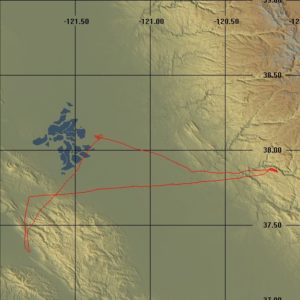 The weather started off foggy, but was burning off quickly when I got to the airport about 11:30am. We were scheduled to fly at 12pm and I needed to complete the flight plan calculations given the forecast winds. I had the first half of the trip completed when Grainne showed up. She had a few questions about the route I had picked but nothing too serious. I had planned to fly a right 45 departure from RHV which is basically due North, climb to 4500’ and then turn East directly over Livermore and climb up to 5500’. That would set me up for a straight line course across the central valley passed Tracy and Oakdale and on to Pine Mountain Lake. For practice I had flown the route on FS2000 the last night and most of the landmarks I’d picked out seemed easy enough to see. The route back would use the 251 degree radial to the Manteca VOR which would take me neatly to the entry to Stockton class D airspace. Grainne had already told me we would probably not land at Stockton, but instead divert to somewhere else, I still had to plan it out though. I filed a flight plan for the outward journey.
The weather started off foggy, but was burning off quickly when I got to the airport about 11:30am. We were scheduled to fly at 12pm and I needed to complete the flight plan calculations given the forecast winds. I had the first half of the trip completed when Grainne showed up. She had a few questions about the route I had picked but nothing too serious. I had planned to fly a right 45 departure from RHV which is basically due North, climb to 4500’ and then turn East directly over Livermore and climb up to 5500’. That would set me up for a straight line course across the central valley passed Tracy and Oakdale and on to Pine Mountain Lake. For practice I had flown the route on FS2000 the last night and most of the landmarks I’d picked out seemed easy enough to see. The route back would use the 251 degree radial to the Manteca VOR which would take me neatly to the entry to Stockton class D airspace. Grainne had already told me we would probably not land at Stockton, but instead divert to somewhere else, I still had to plan it out though. I filed a flight plan for the outward journey.
A normal takeoff and as we climbed towards Calaveras Reservoir I called Oakland Flight Service Station and opened the flight plan, the guy was real nice, he needed to get my name, I guess the recorded message I left when I filed the plan garbled my it and he gave us a frequency for filing pilot reports (PIREPS) and position updates during the journey. We were just leveled off at 4500’ when I called Bay Approach to request flight following. I completely screwed it up, I forgot to tell him where I was, how high I was and what I wanted and I think I forgot to repeat my call-sign a couple of times. In the end he just gave me another frequency to call. I was completely flustered. I started from scratch on the new frequency and thankfully got it right this time – I’m still intimidated by talking to Bay Approach along with all the “real” air traffic in the congested Bay Area. The sequence is not hard, basically you initiate the call with “Bay Approach, Skyhawk 5766J, request”, then wait for them to reply usually with “Skyhawk 5766J, Bay Approach state you request”. Then you tell them where you are and what you want, “Bay Approach, Skyhawk 5766J, 10 miles North of Reid-Hillview, 4,500 feet, request flight following from Reid-Hillview to Pine Mountain Lake”. They then give you a transponder code to squawk, “Skyhawk 5766J, Squawk 0433 and IDENT”. You have to repeat the code back to them to make sure you got it right, “0433, 5766J”, enter it in the transponder and push the IDENT button, this will make it flash on their radar screen so they can pick it out easily. After that they will come back and confirm radar contact, “Skyhawk 5766J, radar contact at 12 miles north of Reid-Hillview, 4,600 feet” and they might ask you to confirm the altitude, “confirm altitude 4,600 feet” to which you reply “Affirmative, 4,600 feet, 5766J”. So you see, a piece of cake really. I was happily heading toward Livermore when they told me I was cleared to climb to 5500’ at my discretion and after that I didn’t hear from them until I was handed off to Stockton Approach somewhere over the Altamont Pass.
The flight went well out to Tracy, I was just a little south of my course at the intersection of I-205 and I-5. The next checkpoint was an intersection of a road and some power lines just outside Oakdale and we hit that one more or less on time. I missed the next checkpoint, it was supposed to be a intersection of a road and a railway, but I never saw it for sure. By this time I knew I was getting fairly close to Pine Mountain Lake, but I was not exactly sure where I was. Finally, I found a bridge that was unmistakable and would have been a much better checkpoint in the first place. Right then I realized that I knew just where I was, the road running across the bridge was highway 120 which is basically the route to Yosemite and I’ve driven it many times, there is a big hydro-electric plant close by that was easy to pick-out near a place called Priests Grade, that’s an incredibly steep hill that worth driving up, but will burn your brakes driving down (I know I’ve done it). Right about this time I saw the airport.
I was a little south of the field so as I descended I flew across it to enter on the downwind leg. I then proceeded to completely screw up the pattern entry. I flew way too close on the downwind, overshot a lot on the turn to final and decided to go around. As I climbed out two planes entered the downwind leg ahead of me so I was now number 3 to land. The wind was brutal, a lot of turbulence and it seemed to be coming from rapidly changing directions. I overshot final again and did another go around. This time Grainne started to talk me through the landing. Third time it worked, the approach was much better. We were just about 50 feet above the ground and for some reason the plane was just floating even with 40 degrees of flaps, suddenly the bottom dropped out and we headed for the ground fast. The flare worked and the actual landing was reasonable. We must have hit some kind of updraft followed by a downdraft just above the ground, it was no fun whatsoever.
Pine Mountain Lake is a “fly-in” community. People actually have houses right next to the taxiways and hangers instead of garages. We taxied to the transient parking and got out to stretch out legs. Grainne once again had to remind me to close my flight plan, which I did by phone. A few minutes on the ground and we decided to head back. Grainne had me do one more loop of the pattern and another landing to make sure I could be more consistent at an unfamiliar airport and to give me a confidence boast that the first landing wasn’t a fluke. The second landing was fine and we did a touch and go. This was probably a mistake because the altitude made the climb out much closer to the trees than either of us would have liked. We departed straight out and I had little trouble picking up the 251degree radial from the Manteca VOR. The air however was really bumpy, the worst turbulence I’ve been in so far, though Grainne said it was only “light”. Once we were back at altitude Grainne had me put on the foggles and I flew on instruments tracking the VOR. This was only hard because of the bouncing around and I did a passable job of staying on course. Of course, once I took the foggles off I had no idea of where I was, other than on the radial so Grainne picked the perfect time to decide to divert me to Lodi. Whether by design or accident Lodi happened to be right on the fold of the map, with the airport on one side and all the associated information on the other. The plane was bouncing around and taking most of my attention to keep it straight and level and I was trying to plot a course to the new airport. The first problem was I didn’t know where I was. I tried triangulating with the Linden VOR and got a rough idea, close enough to very roughly get a course of 285 degrees. Grainne suggested I use the DME (Distance Measurement Equipment) to get the distance to the Manteca VOR, thankfully this agreed fairly closely with my first estimate. Once I’d decided that about 280 was reasonable Grainne had me calculate the ETE (Estimated Time Enroute), the ETA (Estimated Time of Arrival) and the fuel required. Once that was done, I just set the GOTO on my GPS and it gave me a heading of 270 degrees and an ETA that matched mine to the minute (by luck I think).
Actually finding the airport turned out to be a little difficult, there were two airports marked close together on the chart, I could see one below me, but I couldn’t see the other so I wasn‘t sure if I had the right one or not. The ETA (and the GPS) were telling me I’d was over the right airport so I decided to descend and get a better look. I did a descending right turn and as I came around I saw the second airport confirming that I was in fact over the right place, Kingdon Airport. I did a thankfully uneventful entry into left downwind and made a fine landing. There were no taxiways, so we just turned around at the far end of the runway and took off again – there was really no significant wind to force us to take off in any particular direction. We did a crosswind departure which was basically towards home and Grainne told me to just find the fastest way back to RHV.
I could see Mt Diablo in the distance. Reid-Hillview was too far to come up on the “nearest” list on my GPS, but Livermore did so I set that as my destination. I’m pretty familiar with the central valley around Stockton and Tracy so it was easy to set myself up in the right direction. Coming over the Altamont Pass again I could see Mission Peak in the distance, Calaveras Reservoir is right in front so we just made a beeline for familiar airspace. I tried to get a radial from the San Jose VOR, but the mountains got in the way and I didn’t really need it anyway. I got the RHV ATIS and called into the tower over Calaveras. We did a completely standard approach to right traffic for runway 31R though my attempt at a soft-field landing left a lot to be desired.
The trip was fun, though somewhat tiring, almost 3 hours flying and over 200 nm traveled. Other than the problems landing at Pine Mountain Lake it was a good experience. I really didn’t screw anything up badly. I think once I get some more local solo experience I’ll be more than ready to attempt one of these trips on my own.
Thursday October 24th 2002, 5:30pm, N5766J, 0.9H
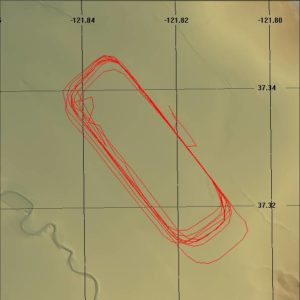 As expected the weather didn’t cooperate for another solo flight. This time the wind and visibility were fine, but there was broken cloud at 3,500’ and it looked like more solid cloud was moving in from the West. However, Yoed was hanging around outside at 4pm when I was supposed to be flying so I asked him if he was available. He had one student for an hour, but would go up with me afterwards. I hung out at Tradewinds working on the flight plan for Saturday’s long cross country and I had 5766J pre-flighted and ready to go when he got back down a little after 5pm. We planned to stay in the pattern at RHV and practice short & soft field landings & takeoffs.
As expected the weather didn’t cooperate for another solo flight. This time the wind and visibility were fine, but there was broken cloud at 3,500’ and it looked like more solid cloud was moving in from the West. However, Yoed was hanging around outside at 4pm when I was supposed to be flying so I asked him if he was available. He had one student for an hour, but would go up with me afterwards. I hung out at Tradewinds working on the flight plan for Saturday’s long cross country and I had 5766J pre-flighted and ready to go when he got back down a little after 5pm. We planned to stay in the pattern at RHV and practice short & soft field landings & takeoffs.
I made a dumb rookie mistake that I’ve never made before, I forgot to call Ground Control before starting to taxi – I was just about to go when Yoed says “Are you just going to start?”, then I realized what I had done – oh well, maybe I should write that one in on my checklist. We had a normal run-up and takeoff from 31L. I was just about the call the Tower when they told me to expedite crossing 31R and takeoff. That break in routine caused me to make my second rookie mistake – I forgot to turn on the transponder and landing light (the usual “lights, camera, action” checklist just before takeoff). From now on I’m going to just turn them on at the end of the run-up unless there’s a long line of planes waiting to takeoff (meaning I’ll have time to remember it then).
We proceed to do 7 takeoffs and landings. All the takeoffs were a combo soft & short technique. Basically, holding the nose wheel off the runway and then flying in ground effect to build speed, then climbing at best angle of climb to simulate clearing an obstacle at the end of the runway. Yoed made a good point, many soft fields are also short so its not unusual to have to combine the techniques. The first few takeoffs were a little ragged with a lot of drift sideways flying in ground effect. Yoed really drilled me on keeping the center line during the takeoff – more right rudder and use the ailerons. This paid off and the last couple of takeoffs were right down the line. Of the seven landings, two were soft-field and the rest were short field. I really had fun with the short field landings. 40 degrees of flaps brings you in steep, the flare is very positive and you really try to plant your wheels on the aiming spot. Two of the landings were my best ever, I aimed for the numbers and planted the mains right down on them, not hard, but just firmly enough that you knew you had arrived. Yoed commented that one was “commercial standard” whatever that means. We only had one go-around, I’m still not sure what went wrong. I believe, I was a little fast and I started to flare early and too much. So I ended up about 15’ above the ground and then started to just drop in. Yoed called for power and then a go around. He seemed real concerned which bothers me because I think I would have still attempted the landing (with just adding power to soften the landing). I’m not sure what exactly I missed that made it so bad. The two soft-field landings were a mixed bag, one was reasonable, the other felt more like a normal landing – I will have to practice these more.
Tonight was fun, Yoed is always nice to fly with – he’s precise and picks up on a lot of little stuff that Grainne lets slide. He’d probably drive me nuts if I flew with him every time, but great for a brush up on technique.

